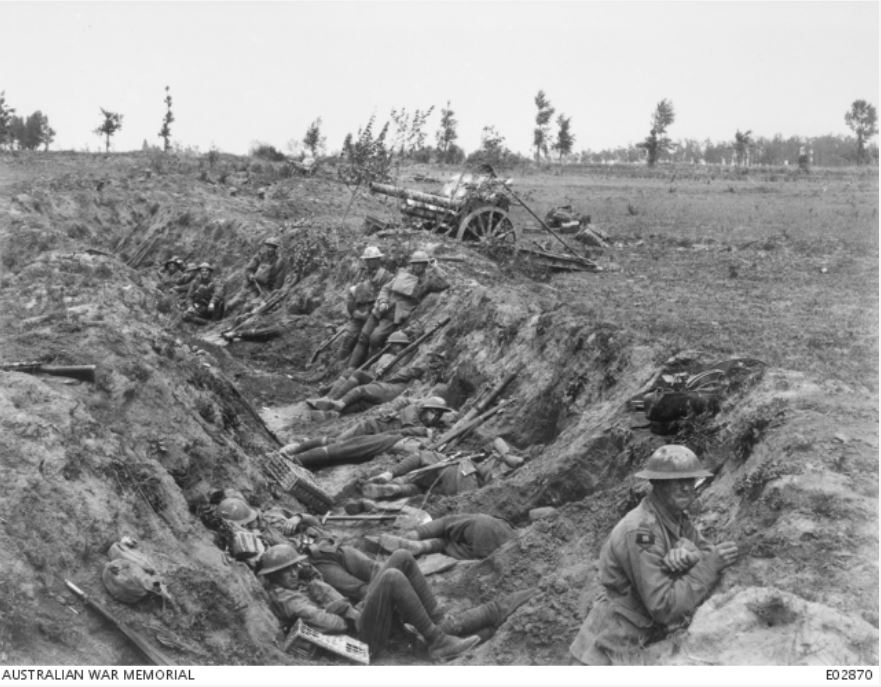10th Battalion
From Our Contribution
 10th Battalion Colour Patch | |
 Trench near Crepy Wood during attack on Lihons. AWM photo E02870 | |
Contents
Brief History
The 10th Battalion was raised shortly after the outbreak of World War I as part of the Australian Imperial Force (AIF), an all-volunteer force raised for overseas service. Recruited in South Australia, the battalion came into being on 17 August 1914 at the Morphettville Racecourse in Adelaide, drawing volunteers mainly from the local population as well as some from Broken Hill in outback New South Wales. Along with the 9th, 11th, and 12th Battalions it formed the 3rd Brigade. 1st Division. Volunteers included men who had previously served in the part-time forces before the war, coming from a variety of units including the 10th Australian Infantry Regiment, which had formerly been known as the "Adelaide Rifles. The battalion was raised within weeks of the declaration of war in August 1914 and embarked for overseas just two months later.
The 3rd Brigade was the covering force for the ANZAC landing on 25 April 1915 and so was, along with other covering force units, first ashore at around 4:30 am. The 10th Battalion was heavily involved in establishing and defending the front line of the ANZAC position, and served there until the evacuation in December. After the withdrawal from Gallipoli, the 10th Battalion returned to Egypt where it was split to form the nucleus of two battalions, the 10th and the 50th. In March 1916, it sailed for France and the Western Front. From then until 1918, the battalion took part in bitter trench warfare.
The battalion's first major action in France was at Pozieres in the Somme valley in July. After Pozieres the battalion fought at Ypres in Flanders before returning to the Somme for winter. In 1917, the battalion returned to Belgium to take part in the major British offensive of that year - the Third Battle of Ypres. In March and April 1918 the 10th Battalion helped stop the German spring offensive and was then involved in the operations leading up to the Allied counter-stroke. The battalion participated in the great allied offensive of 1918, fighting near Amiens on 8 August 1918. This advance by British and empire troops was the greatest success in a single day on the Western Front, one that German General Erich Ludendorff described as "the black day of the German Army in this war".
The battalion continued operations until late September 1918. Casualties totalled 1,015 men killed and 2,136 wounded. In November 1918, members of the AIF began returning to Australia. At 8 am on 5 September 1919, the final detachment of the 10th Battalion arrived at Adelaide, aboard HMT Takada.
Battalion Personnel
- Samuel Vivian Mortimer 28 Feb 1916 - 1 Oct 1917 (WIA)
- Leslie Jeffery Harvey 22 Aug 1917 - 23 Apr 1919 (WIA x 2)
- Ernest Camp 31 Jul 1918 - 19 Sep 1918 - (WIA)
Battle Honours WW1
- ANZAC
- Landing at Anzac
- Defence at Anzac
- Suvla
- Sari Bair
- Gallipoli 1915
- Egypt 1915-16
- Somme 1916-18
- Poziéres
- Bullecourt
- Ypres
- Menin Road
- Polygon Wood
- Broodseinde
- Poelcappelle
- Passchendaele
- Lys
- Hazebrouck
- Kemmel
- Amiens
- Albert 1918
- Hindenburg Line
- Epehy
- France & Flanders 1916-18
Individual Honours
- 3 Victoria Crosses (2Lt Arthur Blackburn, Pte Roy Inwood, Cpl Phillip Davey)
- 1 Companion of the Order of St Michael and St George
- 9 Distinguished Service Orders and one Bar
- 34 Military Crosses and four Bars
- 16 Distinguished Conduct Medals
- 149 Military Medals plus 11 Bars and one second Bar
- 9 Meritorious Service Medals.
References
Content for the history and honours sections has come from a combination of Wikipedia and the Australian War Memorial websites.
For a more detailed report on the activities of this battalion see:
- The Fighting 10th by Cecil Bert Lovell Lock - IWM Facsimilie
- Silent Voices - The Story of the 10th Battalion AIF by Robert Kearney 2005